You're using an outdated browser. Please upgrade to a modern browser for the best experience.
Please note this is an old version of this entry, which may differ significantly from the current revision.
The energy and environmental transition in the building sector requires the development and use of low-impact materials. Despite the growing interest in bio-based and earth-based building materials, their widespread adoption is still limited due to a lack of hindsight, as their study is relatively recent.
- bibliometric
- bio-based building material
- earth-based building material
1. Introduction
The 21st century is the one of global warming awareness. The risks for humanity are major: an increase in natural disasters and their consequences (high mortality, major destruction of buildings and historic sites, etc.), loss of biodiversity, food insecurity, societal conflicts or negative impacts on health (pollution-related pathologies, anxiety, access to drinking water, more pathogens, etc.) [1][2][3][4]. As the construction sector is one of the most environmentally impacting [5][6], research into low-impact building materials has been multiplying in recent years. This especially applies to bio-based and earth-based building materials.
Bio-based materials provide performances that contribute to both energy efficiency and building comfort by incorporating agricultural by-products (hemp shiv, sunflower pith or bark, flax shiv, etc.) or wild plants (reed, bamboo, etc.) [7][8][9]. In the literature, recent reviews of their thermo-hydric performances and applications [10], their fire behaviors [11], the alternative binders used [12], but also the economic and political obstacles to their development [13] are available. No overall analysis has been carried out on this emerging field of research in terms of bibliometric analysis.
Earth-based materials have been used in construction for thousands of years, but their study is relatively new [14]. Their potential is known: low gray energy, low carbon dioxide emissions and recyclability (if not stabilized) [15][16]. Moreover, the hygroscopic capacity of clay-based material ensures indoor hygrometric equilibrium [17]. However, while this eco-material is being used with innovative techniques such as 3D printing [18], it is still difficult to understand its behavior. This presents difficulties of characterization [19] and reproducibility [20]. Review articles examine the environmental benefits of earth construction [15], the effect of incorporating plant fibers or aggregates [14][21], or characterization and production techniques [22][23]. The social, political, and economic aspects of using raw earth in construction have also been studied [24][25]. However, there is neither a comprehensive study nor a bibliometric analysis of the research carried out to date on this ancestral material.
The choice of treating both bio- and geo-based building materials in the same bibliometric study is a conscious one. These materials share a common history. Although they have only recently been studied, ancestral construction techniques demonstrate the relevance of using plant fibers in earth-based matrices [26][27][28]. This is due to the complementary nature of the two materials. Earth is a structural material that passively regulates ambient humidity, thus contributing to the building’s interior comfort [22]. Plant-based aggregates also have the ability to moderate humidity variations in the indoor environment, and no deleterious effects are observed when plant aggregates are incorporated into a clay base, contrary to observations made for certain combinations of aggregates and cementitious matrices [9]. Consequently, the combined effects of the two materials offer great passive humidity regulation capacities [29]. In addition, incorporating plant aggregates can improve the thermal performance of an earth material [30][31][32] and limit its drying shrinkage [33]. A growing number of research projects are exploiting this potential by combining the use of plant-based aggregates and raw earth [34][35][36].
2. Preliminary Statistical Analysis
2.1. Bio-Based Building Materials
-
Increasing number of scientific publications
A small number of research projects were carried out in the late 1990s on bio-based building materials. The field really emerged in the late 2000s (Figure 1).
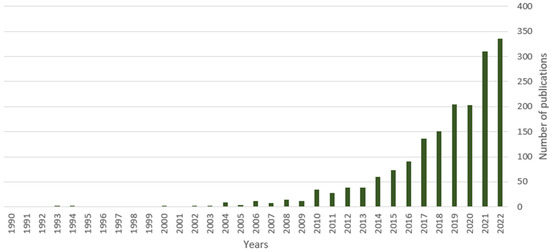
Figure 1. Number of publications concerning bio-based materials between 1990 and 2022 according to Web of Science.
The environmental impact of the construction industry was raised in the literature as early as the 1990s [37][38][39][40]. Bio-based building materials, known for their low environmental impact, became the focus of an increasing number of research projects in the following years. The academic community has embraced environmental issues to propose alternative solutions to conventional building materials [41][42]. Reflecting this global awareness, eco-friendly materials have been the subject of a growing number of publications since the 2010s. In 2020, a temporary slowdown in research activity was observed, likely attributable to the global crisis caused by the Covid virus.
However, the last few years, 2021 and 2022, have shown a notable resurgence in research activity within the field of bio-based building materials.
Furthermore, the publication typology reveals a strong tendency to write original articles (Figure 2). Although research activities in this field are relatively recent, review articles represent a relatively large proportion of the publications. In similar proportions, proceedings account for almost 15% of total publications, with a small percentage of book chapters and “other types” of publications including data papers, meeting abstracts and editorial material.

Figure 2. Typology of publications on bio-based building materials between 1990 and 2022 according to Web of Science data.
-
Geographic and editorial dynamics
Societal and political issues may have diverged, leading to significant disparities among countries [37][43][44]. Looking closely at the countries publishing the most papers on bio-based building materials, it is interesting to note that European countries are well represented, but they are not the only ones. China, France and the United States are the countries most involved in the academic dynamic in the bio-based building materials sector. Regarding authors, a significant portion of publications on the subject of bio-based building materials have been contributed by authors in France and more broadly across Europe.
Finally, Construction and Building Materials is the journal that publishes the most on bio-based building materials. The other leading journals in the discipline have very similar publication frequencies, between 20 and 40 publications per year.
-
Main topics covered
Another valuable aspect of this preliminary statistical study is the list and proportion of topics considered in bio-based building material publications (Figure 3). This demonstrates that fields such as engineering, materials science and chemistry seem to be widely explored, whereas areas like physics, polymer science or environmental sciences (ecology) receive comparatively less attention.
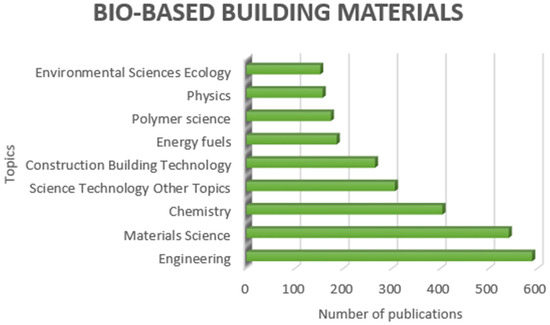
Figure 3. Main topics studied in publications concerning bio-based building materials between 1990 and 2022 according to Web of Science data.
-
Focus on raw materials
An additional analysis of the raw materials used as bio-based building materials was carried out (Figure 4).
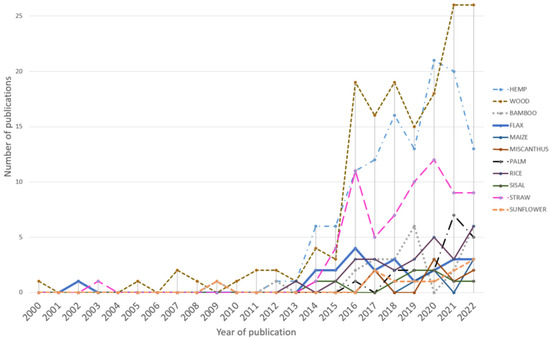
Figure 4. Number of publications for the main raw materials identified in bio-based building materials over the years.
Not surprisingly, wood has been the most widely published topic for almost 20 years. It is followed by hemp, which is also widely studied, well ahead of all other plant-based aggregates. The prevalence of hemp is attributed to its rapid growth in many climates [45]. Additionally, there is promising research on other raw materials from wild plants (such as bamboo) or agricultural by-products (like maize, sunflower, etc.) [46][47]. Since 2015, there has been a growing interest and diversification in the study of raw materials. Particularly, straw stands out with a relatively high number of publications. For other raw materials, it is difficult at this stage to differentiate them in terms of publication dynamics. It should be pointed out that, for the sake of clarity in the graphical representation, raw materials with fewer than five publications in the Web of Science database have been omitted. This group includes jute, reed, cork, mussel or oyster shell, barley, rapeseed and sheep wool. Nevertheless, the extensive range of resources studied is probably an opportunity to use local resources minimizing the environmental footprint of building materials [48]. However, a significant challenge arises in ensuring equivalent performance based on the local resource [49]. Overcoming this scientific bottleneck is crucial for advancing the development of bio-based building materials.
2.2. Earth-Based Building Materials
-
Increasing number of scientific publications
Research related to raw earth building materials emerged in the 1990s (Figure 5). The number of annual publications has significantly increased since 2005, with dynamics in the following years showing a relatively similar trend to that of bio-based building materials.
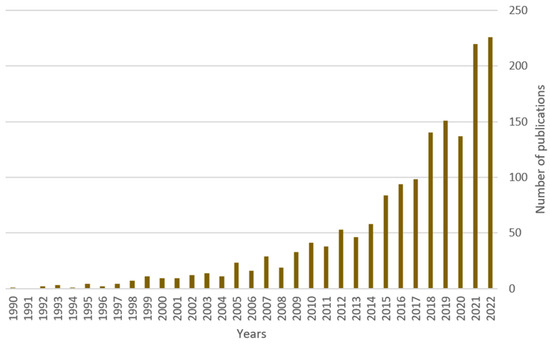
Figure 5. Number of publications concerning earth-based materials between 1990 and 2022, according to Web of Science data.
However, it can be observed that the field of materials using earth as a raw material faces challenges in terms of publication output. In recent years, approximatively 30% fewer publications have been published on geo-based building materials than on bio-based ones. It is certainly a multi-factorial phenomenon that combines a biased representation of the material, a lack of incentive policies and sustainability concerns [24][50][51].
The number of publications remained particularly limited in 2020. This was probably due to the slowdown in research activities during the Covid crisis [52]. However, in subsequent years, publications have been on the rise.
The types of publications also logically show a significant proportion of original articles, such as for bio-based building materials (Figure 6). Review articles represent a small proportion, approximately half of what was observed for bio-based materials. In contrast, the proportion of proceeding materials was much higher, roughly twice as high as that for bio-based materials.
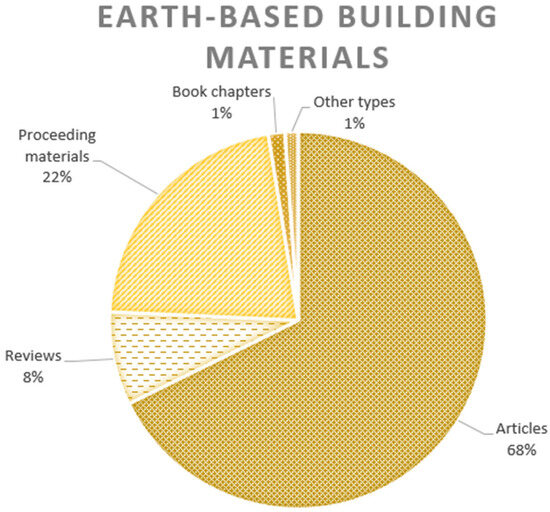
Figure 6. Typology of publications on geo-based building materials between 1990 and 2022 according to Web of Science data.
-
Geographic and editorial dynamics
Despite a large proportion of the population living in earth-based dwellings [53] and the recognized advantages of this material in construction [25], research activities on this subject are concentrated in only a few countries. Over 50% of publications come from the following countries: the United States of America, China, France and Italy.
The majority of authors in the field of raw earth building materials are Europeans. French authors are particularly active in this domain.
Similarly to bio-based building materials, the leading journal for geo-based building materials is Construction and Building Materials. It contributes approximately three to four times more than most other journals in the field.
-
Main topics covered
Interestingly, the main themes covered by the publications closely align with those in bio-based materials. The most represented themes are engineering, materials science and chemistry, while physics and environmental sciences (ecology) remain under-treated (Figure 7).
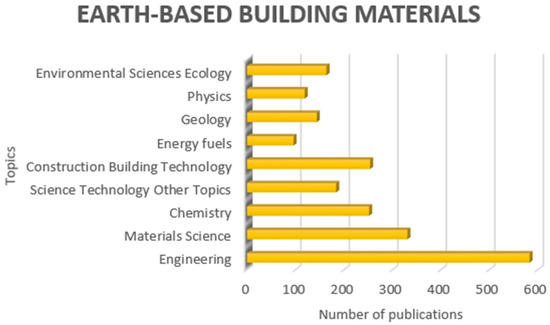
Figure 7. Main topics studied in publications concerning earth-based materials between 1990 and 2022 according to Web of Science data.
This preliminary statistical analysis provides an overview of the research activities carried out on bio- and geo-based building materials since the emergence of these fields. In particular, it highlights the countries and authors driving this domain. Clearly, Europe emerges as a key driver of the ecological transition, supported by these eco-friendly materials. This leadership can be attributed to contemporary history and environmental concerns.
Concern about global warming, its origins and consequences dates back to the 1990s. In response, the United Nations Framework Convention on Climate Change (UNFCCC) was adopted during the 1992 Earth Summit in Rio de Janeiro [54][55]. Negotiations conducted within this context led in 1997 to the Kyoto Protocol [56][57]. The objective was a 5% reduction in greenhouse gas emissions compared to 1990 levels by 2005. The European Union undertook an 8% reduction in its first commitment period (2008–2012). On 31 May 2002, the Kyoto Protocol was ratified by both the EU and its member states. Europe’s commitment was reiterated in 2005 with new objectives, while the United States and China made no secret of their reluctance to ratify the protocol [58][59][60].
Europe’s strong political engagement in the 2000s is certainly at the origin of its leadership in researching environmentally friendly materials [61][62]. The early 2000s coincided with the very beginning of research activities in bio- and geo-based building materials. Since then, Europe has clearly supported innovation and research for a greener and more sustainable society. One example is the EU’s Horizon 2020 framework program, with an overall budget of approximatively EUR 70,000 million over seven years (2014–2020) [63]. Another example is the Interreg POCTEFA scheme [64][65] that financed the trans-Pyrenean SAVASCO project, which aims to establish a cross-border value-added chain for corn and sunflower stalks for the construction industry [66][67]. Another example is the CobBauge project funded under the INTERREG VA France (Channel)/England cross-border cooperation program [68][69], promoting raw earth construction.
Today, Europe is aiming for carbon neutrality by 2050 and making it a top priority through the Green Deal initiative [70]. To reach this objective, continued support for research, particularly in the field of eco-construction, will be crucial.
-
Focus on implementation techniques
An additional analysis of the implementation techniques and associated studies was carried out concerning geo-based building materials (Figure 8).
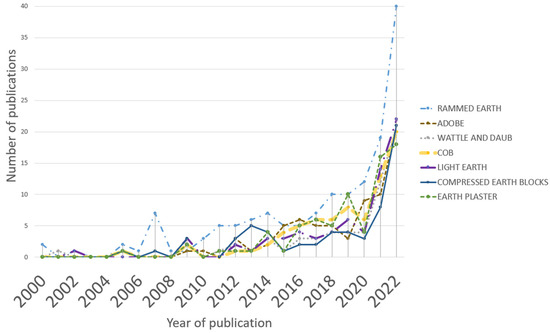
Figure 8. Number of publications for the main implementation techniques of geo-based building materials over the years.
3. Comparative Study with Composite Building Materials
3.1. Evolution in the Number of Publications on Composite Materials
It seemed interesting to compare the evolutionary dynamics of bio- and geo-sourced materials with a research field that emerged a few decades earlier, in the 1960s—composite materials. To take a global view and appreciate the research dynamics in these materials, the statistical study was not limited to composite materials used in construction. All sectors have been considered here (Figure 9).
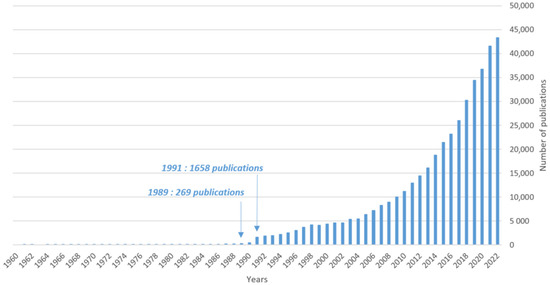
Figure 9. Number of publications concerning composite materials between 1960 and 2022 according to Web of Science data.
-
Obviously, the number of publications is extremely high, providing an overall perspective. What is striking is the number of publications, which increased more than six-fold between 1989 and 1991. It is legitimate to question the reasons for this major breakthrough in composite materials and related work in those years.
-
The 1990s marked the beginning of the computer age. Since then, computer networks have been driving progress in science and engineering [71]. One possible explanation for the inflection point in publication growth is the development of computer technology. Before the 2000s, numerous publications incorporating computerized tools were noticed [72][73][74][75].
3.2. Emerging Themes and Tools for New Developments
In order to assess the above hypothesis, the evolution of the number of publications related to composite materials dealing with modeling, which requires the use of computer tools, was observed around the year 2000 (Figure 11).
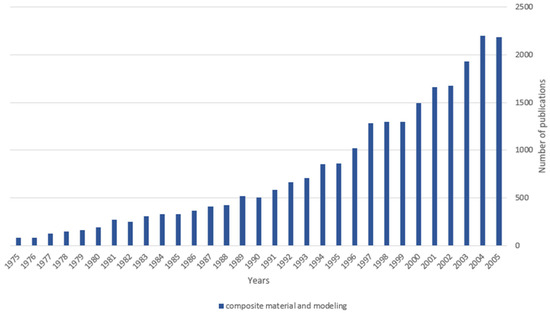
Figure 11. Number of publications concerning modeling and composite materials in the 2000s according to Web of Science data.
Between 1990 and 2000, the number of research projects focused on modeling composite materials tripled. The use of IT tools was undoubtedly a major lever in the development of these emerging materials.
The exploration of new and promising research themes could also explain the rapid growth in the number of publications. A comparative study of the themes studied before and after 1990 were carried out (Figure 12).
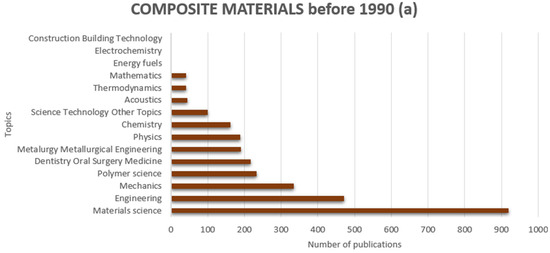
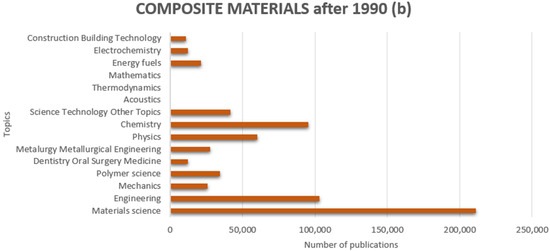
Figure 12. Main research areas studied in the field of composite materials from 1960 to 1990 (a) and from 1990 to 2022 (b) according to Web of Science data.
This comparison reveals that the fields emerging after the 90s were the hard sciences, particularly chemistry and physics. They have respectively risen from 8th and 7th place to 3rd and 4th place in the list of main themes covered. One of the mainsprings for the development of composite materials is probably a better understanding of their physico-chemical behavior.
3.3. Eco-Materials: What about Modeling and the Hard Sciences?
The subject of modeling in bio- and geo-based building materials seems to be in its infancy, as indicated by the number of publications over the years (Figure 13).
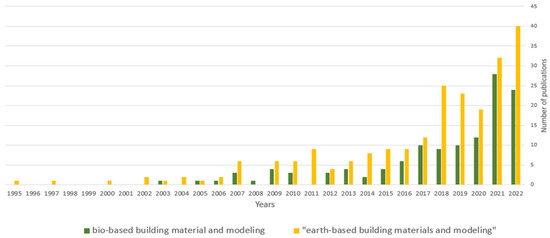
Figure 13. Number of publications concerning modeling and bio-based or geo-based building materials according to Web of Science data.
The number of publications related to modeling in the two research areas is increasing. Cumulatively, it represents 7% of the total number of publications for bio-based building materials and 15% for geo-based ones. By comparison, modeling is involved in 6% of publications on composite materials. However, if the focus is limited to construction-related composites: from the 19,459 publications reported by Web of Science, 5166 deal with modeling, accounting for over 26%. This suggests that modeling is still underexplored with regard to bio- and geo-based building materials.
Secondly, the percentage of works exploring physics and chemistry has been determined as a proportion of the total number of publications for each research area (Figure 14).
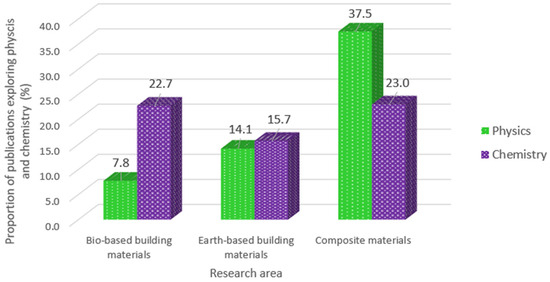
Figure 14. Proportion of publications, from 1900 to 2022, dealing with physics or chemistry in different types of materials according to Web of Science data.
Chemistry’s contribution to bio-based building materials and composites is very similar. It is slightly less represented for raw earth building materials However, the notable disparity lies in the field of physics. Physics appears to be relatively underexplored in the field of eco-materials, whereas it plays a significant role in more than a third of publications in the composite domain.
In conclusion, it appears that physics and modeling tools are probably the levers to be considered for improving knowledge of bio- and geo-sourced building materials and contributing to their development.
4. Bibliometric Networks
4.1. Bio-Based Building Materials
-
Main authors and their collaborations
The analysis of the co-authorship link reveals the main contributors in the field of bio-based building materials (Figure 15). The advantage of visualization maps is to enable an appreciation of the collaborations between the different authors, in addition to their individual contribution. To provide a temporal dimension to the visualization, a time scale can be added.
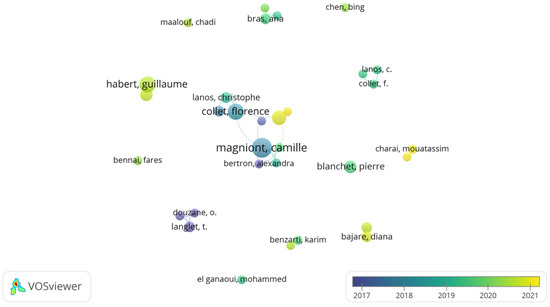
Figure 15. Co-authorship networks of authors (with minimum of five publications) concerning bio-based building materials, with time scale over the last few years.
This map highlights the main authors identified in the previous study. Collaboration between major authors appears to be generally low, especially if they have different affiliations. The only notable exception is the recent collaboration between colleagues from the University of Toulouse and Rennes. Moreover, according to these results, it appears that international cooperation is currently limited.
-
Founding works
An interesting feature is the possibility of identifying the founding works of the discipline. The analysis of reference co-citation links reveals the most widely cited and associated works (Figure 16). For better readability of references and their importance, the visualization density map has been preferred to the visualization network map.
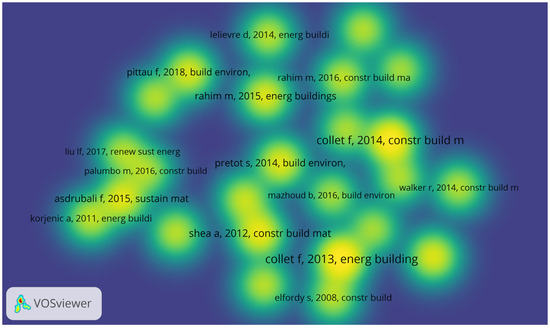
This approach can be very useful for targeting the main works to be consulted when beginning a research work on bio-based building materials. It can be pointed out that these publications are globally concentrated around the year 2015.
-
Key themes in the literature
Analysis of the co-occurrence of keywords in the 570 selected publications (cf. Section 2.2) reveals four clusters, representing the four main themes explored in the literature (Figure 17).
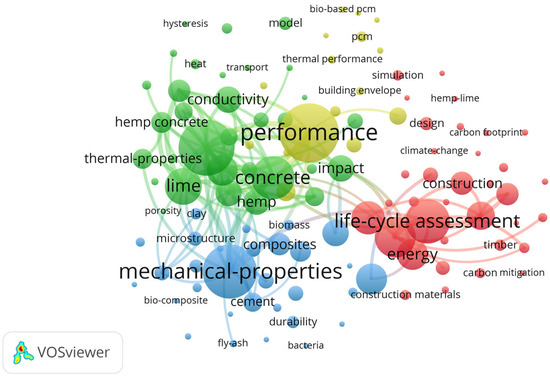
Figure 17. Co-occurrence networks of keywords concerning bio-based building materials.
The analysis of the clusters generated by the VOSviewer software allows their identification. However, it is worth mentioning that this is not always easy, as some themes are shared by several clusters, such as mechanical properties. Therefore, the general theme assigned to each cluster is an interpretation based on the articles identified in each cluster.
The complexity of bio-sourced materials may explain the interweaving of the different themes. Nonetheless, these research topics enable one to identify the current areas of research. Interestingly, none of the clusters directly refers to the hard sciences like physics, and the concept of “model” appears only modestly in the cluster related to thermo-hydric behavior.
-
Focus on main raw materials
-
In order to provide a closer insight into the contributions made to date on the main raw materials identified in Section 3.1.1, an analysis of keyword co-occurrence was carried out within the relevant publications. The visualization includes a time scale to emphasize trends over recent years. For the sake of relevance, this section focuses exclusively on primary resources with more than 10 publications each: hemp, wood, bamboo, flax, palm, rice, straw, sunflower (Figure 18).
These maps highlight the keywords corresponding to the topics mainly studied for each raw material. The notion of life cycle assessment appears to be one of the most discussed subjects in the literature concerning the raw materials considered. However, this subject does not emerge for some of them, thereby highlighting new areas of work. This multi-criteria analysis enables people to objectively demonstrate the benefit of using bio-based materials compared to conventional ones [7]. Notably, the concepts of performance (thermal, hygrothermal, mechanical) are well represented, in line with their function in construction. Wood, hemp and straw naturally yield a richer array of keywords due to their extensive research focus. Wood, used as a structural element, is highlighted by the keywords “timber” and “mechanical properties”. Hemp shiv, often added to a binding matrix (lime, cement) for hemp concrete, is highlighted by the map. An earth-based binder matrix is also possible, which explains the keyword “clay”. Straw, used for insulating wood structures or as a substitute for hemp in plant-based concrete, offers properties very similar to those of hemp. This explains the great similarities between the maps for straw and hemp.
All of the topics covered in wood, hemp and straw are inspirational sources for continuing to develop knowledge of other raw materials applicable to bio-based building materials. These include the following topics:
- -
-
“Cellulose”: linked to the chemical composition of the resource, particularly relevant to wood as a primary chemical compound.
- -
-
“Moisture content”: in relation to water adsorption by the material and potential pathologies arising under such conditions.
- -
-
“Sustainability“: referring to the evolution of a material’s properties under various stresses, including temperature and relative humidity variations over its lifetime.
- -
-
“Energy”: related to the overall energy efficiency of the building, i.e., covering a more global scale than that of the material or the wall.
It should not be overlooked that the development of bio-based building materials also requires taking into account the diversity of resources, which probably has an impact on their use properties [91][92]. Lastly, the use of local raw materials necessitates the establishment of effective harvesting and recovery procedures [67].
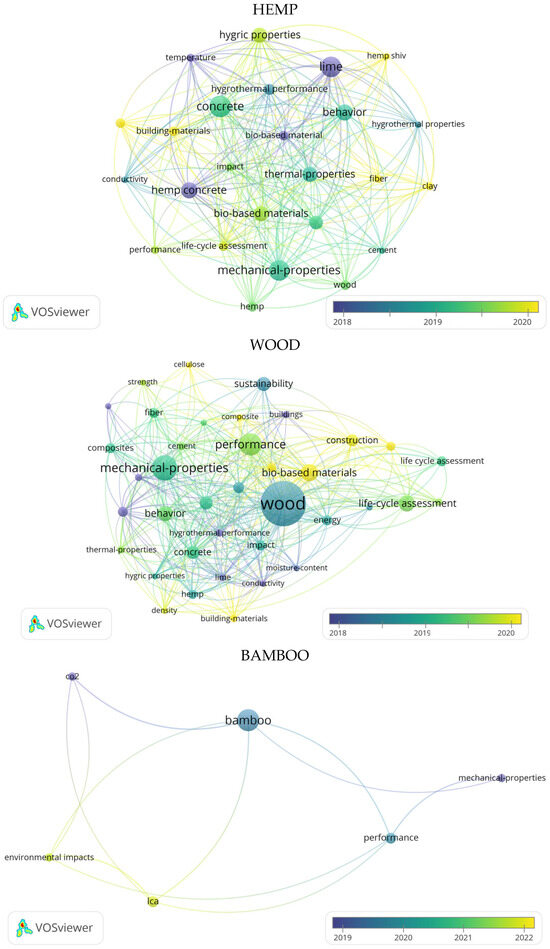
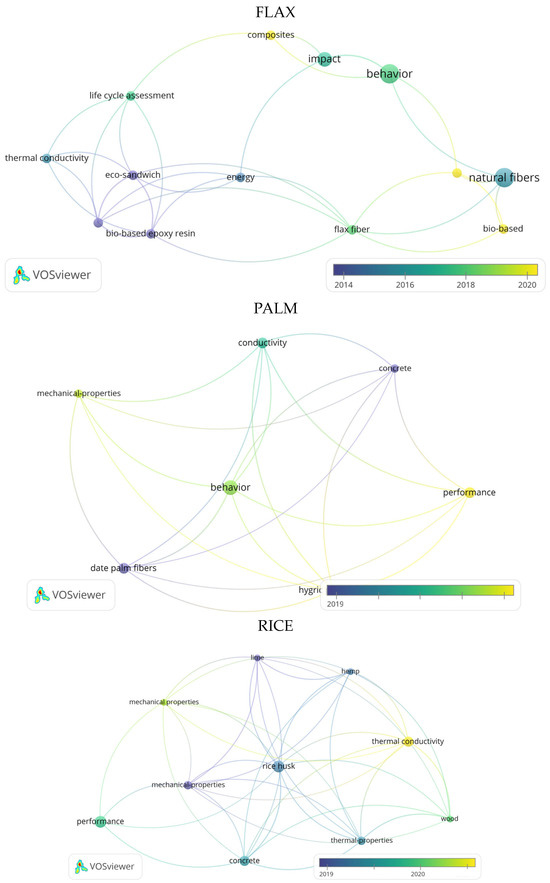
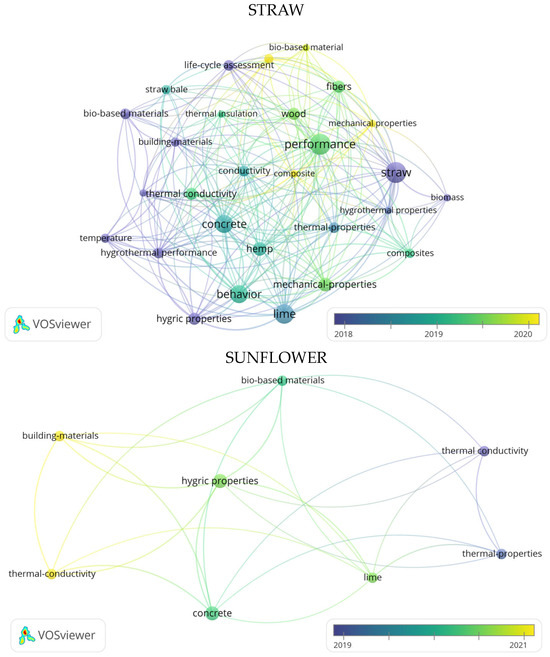
Figure 18. Co-occurrence networks of keywords concerning publications about the most widely studied implementation techniques in the literature.
4.2. Geo-Based Building Materials
-
Main authors and their collaborations
The main contributors in the geo-based building materials sector and their collaborations are presented (Figure 19).
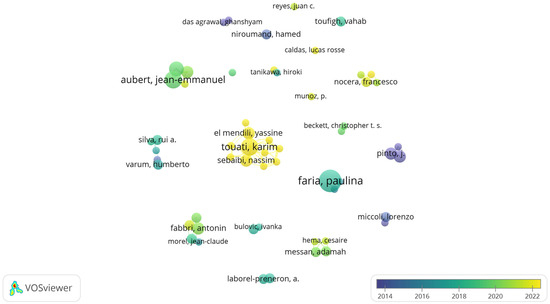
Figure 19. Co-authorship networks of authors (with minimum of three publications) concerning geo-based building materials, with time scale over the last few years.
According to this map, collaboration between authors appears even more limited than that for bio-based building materials. The few collaborations that are visualized mostly involve authors from the same affiliation. The time scale shows that the number of collaborations have been multiplying very recently. No significant European or international collaborations are to be reported, since they involve authors from the same country and often from the same affiliation.
-
Founding works
-
The most frequently cited research works date from the 1990s to 2000s (Figure 20). These works are considered foundational in the field.
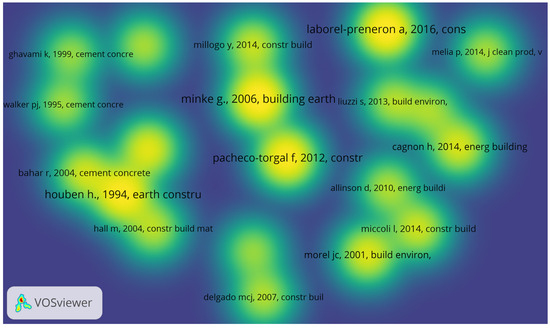
Similarly to bio-based materials, this list of works can help identify fundamental results in the field of raw earth building materials research.
-
Co-authorship links
Analysis of the co-occurrence of keywords in the 504 selected publications (cf. Section 2.2) reveals four clusters, i.e., four main themes explored in the literature (Figure 21).
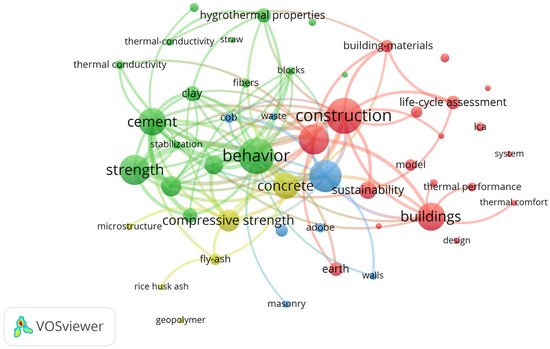
Figure 21. Co-occurrence networks of keywords concerning geo-based building materials.
The keywords mainly associated with the research work do not highlight strong themes related to the hard sciences. It is reasonable to conclude that physics in particular is a little-explored field. Moreover, modeling, which is identified in the “environmental impact” cluster, is clearly very little covered.
-
Focus on implementation techniques
-
In order to provide a closer insight into the contributions concerning implementation in Section 3.1, an analysis of keyword co-occurrence was carried out on the publications relating to them. The time scale is added to the visualizations to underline the trend over the last few years. All techniques are included, as they have been studied in over 10 publications (Figure 22).
In load-bearing techniques such as rammed earth, adobe, cob and compressed earth blocks, terminology related to mechanical properties is logically prevalent. For wattle and daub, the subjects span a broader spectrum, ranging from microstructure to mechanical properties and organic acids. The hygrothermal properties of plasters are clearly targeted by the studies carried out to date. It is interesting to note that the term “cement” appears on many cards. This may appear surprising, but it certainly stems from the systematic comparison of earth materials with conventional ones. The emergence of the terms “fibers” and “rice husk” demonstrates the close link between bio- and geo-based building materials. Identified areas for further exploration to address certain limitations likely include:
- -
- -
- -
- -
-
Life cycle assessment: as earth is a low-embodied carbon construction material [24], life cycle assessment methodology may adequately demonstrate its potential in place of conventional materials.
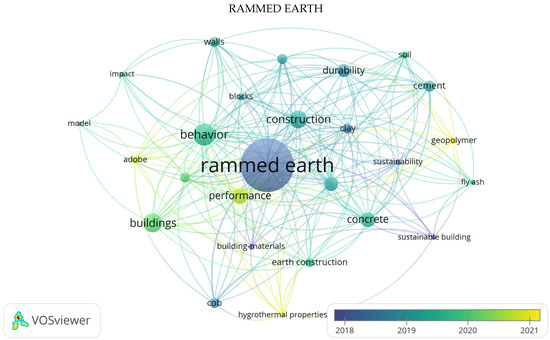

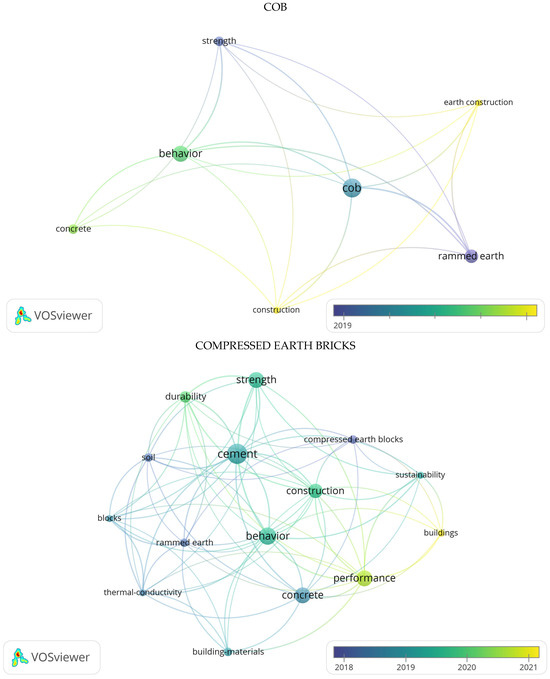
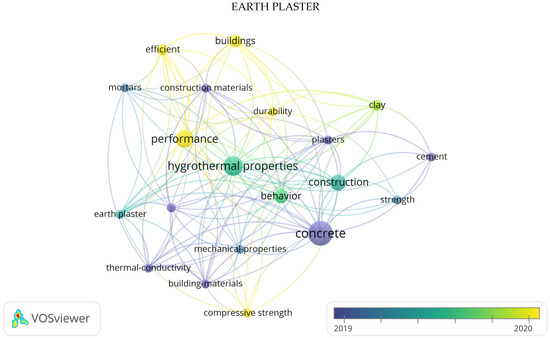
Figure 22. Co-occurrence networks of keywords concerning publications about the most widely studied raw materials in the literature.
4.3. Potential Emerging Themes
The visualization maps in the sections focusing on bio- and geo-based building materials enable one to appreciate the most frequently addressed themes and, consequently, those that are less explored. To further enhance the analysis, a co-occurrence map of key words corresponding to articles on composite building materials in 2022 has been generated. By comparison, this allows the detection of different themes that could potentially contribute to the development of eco-materials (Figure 23).
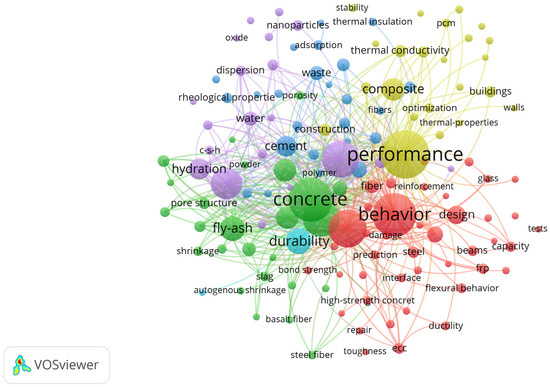
Figure 23. Co-occurrence networks of keywords concerning composite building materials (2022).
Logically, topics similar to eco-materials can be found, such as mechanical behavior and performance. Performance is linked in an interesting way to optimization, which was not identified in the case of bio- and geo-based building materials. This suggests it as a first avenue of study.
In the context of composite building materials, it is worth noting that the study of behavior is linked to modeling with the notion of machine learning. This link was not represented in previous maps, making it another avenue of exploration.
This entry is adapted from the peer-reviewed paper 10.3390/constrmater3040031
References
- Richards, C.E.; Lupton, R.C.; Allwood, J.M. Re-framing the threat of global warming: An empirical causal loop diagram of climate change, food insecurity and societal collapse. Clim. Chang. 2021, 164, 49.
- Higano, Y.; Otsuka, A. Special Feature on Regional Sustainability: Analysis in a spatial and regional context with broad perspectives on the risk of global warming, natural disasters, and emerging issues due to the globalized economy. Asia-Pacific J. Reg. Sci. 2022, 6, 239–245.
- Rossati, A. Global Warming and Its Health Impact. Int. J. Occup. Environ. Med. 2017, 8, 7–20.
- Khan, I.; Rehman, A.; Zia, K.; Naveed, U.; Bibi, S.; Sherazi, R.; Hussain, I.; Ur Rehman, M.; Massa, S. Microbes and Environment: Global Warming Reverting the Frozen Zombies. In Environment, Climate, Plant and Vegetation Growth; Fahad, S., Hasanuzzaman, M., Alam, M., Ullah, H., Saeed, M., Ali Khan, I., Adnan, M., Eds.; Springer International Publishing: Cham, Switzerland, 2020; pp. 607–633.
- Ürge-Vorsatz, D.; Khosla, R.; Bernhardt, R.; Chan, Y.C.; Vérez, D.; Hu, S.; Cabeza, L.F. Advances Toward a Net-Zero Global Building Sector. Annu. Rev. Environ. Resour. 2020, 45, 227–269.
- Ali, K.A.; Ahmad, M.I.; Yusup, Y. Issues, Impacts, and Mitigations of Carbon Dioxide Emissions in the Building Sector. Sustainability 2020, 12, 7427.
- Mouton, L.; Allacker, K.; Röck, M. Bio-based building material solutions for environmental benefits over conventional construction products—Life cycle assessment of regenerative design strategies (1/2). Energy Build. 2023, 282, 112767.
- Jones, D.; Brischke, C. Performance of Bio-Based Building Materials; Woodhead Publishing: Sawston, UK, 2017.
- Lagouin, M.; Magniont, C.; Sénéchal, P.; Moonen, P.; Aubert, J.-E.; Laborel-Préneron, A. Influence of types of binder and plant aggregates on hygrothermal and mechanical properties of vegetal concretes. Constr. Build. Mater. 2019, 222, 852–871.
- Bourbia, S.; Kazeoui, H.; Belarbi, R. A review on recent research on bio-based building materials and their applications. Mater. Renew. Sustain. Energy 2023, 12, 117–139.
- Yang, Y.; Haurie, L.; Wang, D.-Y. Bio-based materials for fire-retardant application in construction products: A review. J. Therm. Anal. Calorim. 2022, 147, 6563–6582.
- Bumanis, G.; Vitola, L.; Pundiene, I.; Sinka, M.; Bajare, D. Gypsum, Geopolymers, and Starch—Alternative Binders for Bio-based Building Materials: A Review and Life-Cycle Assessment. Sustainability 2020, 12, 5666.
- Dams, B.; Maskell, D.; Shea, A.; Allen, S.; Cascione, V.; Walker, P. Upscaling bio-based construction: Challenges and opportunities. Build. Res. Inf. 2023, 51, 764–782.
- Laborel-Préneron, A.; Aubert, J.; Magniont, C.; Tribout, C.; Bertron, A. Plant aggregates and fibers in earth construction materials: A review. Constr. Build. Mater. 2016, 111, 719–734.
- Pacheco-Torgal, F.; Jalali, S. Earth construction: Lessons from the past for future eco-efficient construction. Constr. Build. Mater. 2012, 29, 512–519.
- Boussaa, N.; Kheloui, F.; Chelouah, N. Mechanical, thermal and durability investigation of compressed earth bricks stabilized with wood biomass ash. Constr. Build. Mater. 2023, 364, 129874.
- Santos, T.; Gomes, M.I.; Silva, A.S.; Ferraz, E.; Faria, P. Comparison of mineralogical, mechanical and hygroscopic characteristic of earthen, gypsum and cement-based plasters. Constr. Build. Mater. 2020, 254, 119222.
- Perrot, A.; Rangeard, D.; Courteille, E. 3D Printing of Earth-Based Materials: Processing Aspects. Constr. Build. Mater. 2018, 172, 670–676.
- Fabbri, A.; Morel, J.C.; Aubert, J.-E.; Bui, Q.-B.; Gallipoli, D.; Ventura, A.; Reddy, V.B.V.; Hamard, E.; Pelé-Peltier, A.; Abhilash, H.N. An overview of the remaining challenges of the RILEM TC 274-TCE, testing and characterisation of earth-based building materials and elements. RILEM Tech. Lett. 2021, 6, 150–157.
- Azil, A.; Le Guern, M.; Touati, K.; Sebaibi, N.; Boutouil, M.; Streiff, F.; Goodhew, S.; Gomina, M. Earth construction: Field variabilities and laboratory reproducibility. Constr. Build. Mater. 2022, 314, 125591.
- Paul, S.; Islam, M.S.; Elahi, T.E. Comparative effectiveness of fibers in enhancing engineering properties of Earth as a building Material: A review. Constr. Build. Mater. 2022, 332, 127366.
- Fabbri, A.; Morel, J.-C.; Gallipoli, D. Assessing the performance of earth building materials: A review of recent developments. RILEM Tech. Lett. 2018, 3, 46–58.
- Shubbar, A.A.; Sadique, M.; Kot, P.; Atherton, W. Future of clay-based construction materials—A review. Constr. Build. Mater. 2019, 210, 172–187.
- Pelé-Peltier, A.; Charef, R.; Morel, J.-C. Factors affecting the use of earth material in mainstream construction: A critical review. Build. Res. Inf. 2023, 51, 119–137.
- Zami, M.S.; Lee, A. Economic benefits of contemporary earth construction in low-cost urban housing—State-of-the-art review. J. Build. Apprais. 2010, 5, 259–271.
- Bamogo, H.; Ouedraogo, M.; Sanou, I.; Ouedraogo, K.A.J.; Dao, K.; Aubert, J.-E.; Millogo, Y. Improvement of water resistance and thermal comfort of earth renders by cow dung: An ancestral practice of Burkina Faso. J. Cult. Heritage 2020, 46, 42–51.
- Khtou, O.; Aalil, I.; Aboussaleh, M.; EL Wardi, F.Z. Mechanical Analysis of Fiber Reinforced Adobe. Civ. Eng. Arch. 2021, 9, 2160–2168.
- Guerrero Baca, L.F. The Use of Cob in the Intervention of Adobe Construction Components. Interv. México DF 2020, 11, 133–187.
- Lima, J.; Faria, P. Eco-Efficient Earthen Plasters: The Influence of the Addition of Natural Fibers. In Natural Fibres: Advances in Science and Technology Towards Industrial Applications; Fangueiro, R., Rana, S., Eds.; RILEM Bookseries; Springer: Dordrecht, The Netherlands, 2016; pp. 315–327.
- Laborel-Préneron, A.; Magniont, C.; Aubert, J.-E. Hygrothermal properties of unfired earth bricks: Effect of barley straw, hemp shiv and corn cob addition. Energy Build. 2018, 178, 265–278.
- Giroudon, M.; Laborel-Préneron, A.; Aubert, J.-E.; Magniont, C. Comparison of barley and lavender straws as bioaggregates in earth bricks. Constr. Build. Mater. 2019, 202, 254–265.
- Bouasria, M.; El Mendili, Y.; Benzaama, M.-H.; Pralong, V.; Bardeau, J.-F.; Hennequart, F. Valorisation of stranded Laminaria digitata seaweed as an insulating earth material. Constr. Build. Mater. 2021, 308, 125068.
- Lagouin, M.; Laborel-Préneron, A.; Magniont, C.; Geoffroy, S.; Aubert, J.-E. Effects of organic admixtures on the fresh and mechanical properties of earth-based plasters. J. Build. Eng. 2021, 41, 102379.
- Jonkers, H.M. Toward Bio-based geo- & Civil Engineering for a Sustainable Society. Procedia Eng. 2017, 171, 168–175.
- Lagouin, M.; Laborel-Préneron, A.; Magniont, C.; Geoffroy, S.; Aubert, J.-E. Moisture buffer capacity of a bilayer bio- and geo-based wall. Constr. Build. Mater. 2022, 329, 127209.
- Brümmer, M.; Sáez-Pérez, M.P.; Suárez, J.D. Hemp-Clay Concretes for Environmental Building—Features that Attribute to Drying, Stabilization with Lime, Water Uptake and Mechanical Strength. In Advances in Natural Fibre Composites; Fangueiro, R., Rana, S., Eds.; Springer International Publishing: Cham, Switzerland, 2018; pp. 249–265.
- Spence, R.; Mulligan, H. Sustainable development and the construction industry. Habitat Int. 1995, 19, 279–292.
- Vanegas, J.; DuBose, J.; Pearce, A. Sustainable Technologies for the Building Construction Industry. Jan. 1995. Available online: https://www.researchgate.net/publication/228540323_Sustainable_technologies_for_the_building_construction_industry (accessed on 20 November 2023).
- Ofori, G.; Briffett, C.; Gang, G.; Ranasinghe, M. Impact of ISO 14000 on construction enterprises in Singapore. Constr. Manag. Econ. 2000, 18, 935–947.
- Gavilan, R.M.; Bernold, L.E. Source Evaluation of Solid Waste in Building Construction. J. Constr. Eng. Manag. 1994, 120, 536–552.
- Venkatarama Reddy, B.V.; Jagadish, K.S. Embodied energy of common and alternative building materials and technologies. Energy Build. 2003, 35, 129–137.
- Melià, P.; Ruggieri, G.; Sabbadini, S.; Dotelli, G. Environmental impacts of natural and conventional building materials: A case study on earth plasters. J. Clean. Prod. 2014, 80, 179–186.
- Khator, R. The new paradigm: From development administration to sustainable development administration. Int. J. Public Adm. 1998, 21, 1777–1801.
- Delmas, M.A. The diffusion of environmental management standards in Europe and in the United States: An institutional perspective. Policy Sci. 2002, 35, 91–119.
- Yadav, M.; Agarwal, M. Biobased building materials for sustainable future: An overview. Mater. Today Proc. 2021, 43, 2895–2902.
- Arufe, S.; de Menibus, A.H.; Leblanc, N.; Lenormand, H. Physico-chemical characterisation of plant particles with potential to produce biobased building materials. Ind. Crop. Prod. 2021, 171, 113901.
- Göswein, V.; Reichmann, J.; Habert, G.; Pittau, F. Land availability in Europe for a radical shift toward bio-based construction. Sustain. Cities Soc. 2021, 70, 102929.
- Aghamohammadi, N.; Shahmohammadi, M. Chapter 8—Towards sustainable development goals and role of bio-based building materials. In Bio-Based Materials and Waste for Energy Generation and Resource Management; Hussain, C.M., Kushwaha, A., Bharagava, R.N., Goswami, L., Eds.; Advanced Zero Waste Tools; Elsevier: Amsterdam, The Netherlands, 2023; Volume 5, pp. 243–279.
- Mazian, B.; Bergeret, A.; Benezet, J.-C.; Bayle, S.; Malhautier, L. Impact of Field Retting on the Hemp Fibres Structure. Rev. Compos. Matér. Avancés 2019, 29, 277–282.
- Zoungrana, O.; Bologo/Traoré, M.; Messan, A.; Nshimiyimana, P.; Pirotte, G. The Paradox around the Social Representations of Compressed Earth Block Building Material in Burkina Faso: The Material for the Poor or the Luxury Material? Open J. Soc. Sci. 2021, 9, 50–65.
- Morel, J.-C.; Charef, R.; Hamard, E.; Fabbri, A.; Beckett, C.; Bui, Q.-B. Earth as construction material in the circular economy context: Practitioner perspectives on barriers to overcome. Philos. Trans. R. Soc. B Biol. Sci. 2021, 376, 20200182.
- Donthu, N.; Gustafsson, A. Effects of COVID-19 on business and research. J. Bus. Res. 2020, 117, 284–289.
- Avrami, E.; Guillaud, H.; Hardy, M. (Eds.) Terra Literature Review: An Overview of Research in Earthen Architecture Conservation; Getty Conservation Institute: Los Angeles, CA, USA, 2008; Available online: http://hdl.handle.net/10020/gci_pubs/terra_literature_review (accessed on 20 November 2023).
- Andonova, L.B.; Hoffmann, M.J. From Rio to Rio and Beyond: Innovation in Global Environmental Governance. J. Environ. Dev. 2012, 21, 57–61.
- Panjabi, R.K.L. The Earth Summit at Rio: Politics, Economics and the Environment. Chapter 4. 1997. Available online: https://www.cabdirect.org/cabdirect/abstract/19981806031 (accessed on 5 September 2023).
- Böhringer, C. The Kyoto Protocol: A Review and Perspectives. Oxf. Rev. Econ. Policy 2003, 19, 451–466.
- Prins, G.; Rayner, S. The Kyoto Protocol. Bull. At. Sci. 2008, 64, 45–58.
- Ghezloun, A.; Saidane, A.; Oucher, N.; Chergui, S. The Post-Kyoto. Energy Procedia 2013, 36, 1–8.
- Gong, G.J. What China wants: China’s climate change priorities in a post-Copenhagen world. Glob. Chang. Peace Secur. 2011, 23, 159–175.
- Depledge, J. Against the grain: The United States and the global climate change regime. Glob. Chang. Peace Secur. 2005, 17, 11–27.
- Connelly, R.K.W.W.A.J. Introduction: European Union political leadership in international climate change politics. In The European Union as a Leader in International Climate Change Politics; Routledge: London, UK, 2010.
- Viguier, L.L.; Babiker, M.H.; Reilly, J.M. The costs of the Kyoto Protocol in the European Union. Energy Policy 2003, 31, 459–481.
- Pacheco-Torgal, F. Eco-efficient construction and building materials research under the EU Framework Programme Horizon 2020. Constr. Build. Mater. 2014, 51, 151–162.
- Martín-Uceda, J.; Rufí, J.V. Territorial Development and Cross-Border Cooperation: A Review of the Consequences of European INTERREG Policies on the Spanish–French Border (2007–2020). Sustainability 2021, 13, 12017.
- Feliu, J.; Berzi, M.; Vicente, J.; Castañer, M.; Llussà, R. Analysis of cross-border projects between France and Spain 2007–2013. Eur. J. Geogr. 2013, 4, 33–46.
- Lagouin, M.; Bire, D.; Bory, J.-B.; Evon, P.; Labonne, L.; Laborel-Preneron, A.; Magniony, C. Structuration d’une filière de valorisation transfrontalière des tiges de maïs et de tournesol pour la construction. Acad. J. Civ. Eng. 2022, 40, 1.
- Avellaneda, A.; Evon, P.; Haurie, L.; Laborel-Préneron, A.; Lagouin, M.; Magniont, C.; Navarro, A.; Palumbo, M.; Torres, A. Evaluation of the Potential of Plant Aggregates from Corn and Sunflower Stalks for the Design of Building Materials. In Bio-Based Building Materials; Amziane, S., Merta, I., Page, J., Eds.; RILEM Bookseries; Springer Nature: Cham, Switzerland, 2023; pp. 70–86.
- Azil, A.; Le Guern, M.; Rattier, R.; Touati, K.; Sebaibi, N.; El Mendili, Y.; Boutouil, M.; Streiff, F.; Goodhew, S.; Louahlia, H. Réalisation d’un bâtiment pilote en terre-fibres. Acad. J. Civ. Eng. 2020, 38, 1. Available online: https://hal.science/hal-03331999 (accessed on 14 September 2023).
- Fox, M.; Le Guern, M.; Carfrae, J.; Touati, K.; Strieff, F.; Boutouil, M.; Goodhew, S. An Investigation into the Potential Use of TDR Measurement Systems to Accurately Assess the Moisture Content at the Centre of Completed Earth Walls. 2022. Available online: https://pearl.plymouth.ac.uk/handle/10026.1/19510 (accessed on 14 September 2023).
- Maris, G.; Flouros, F. The Green Deal, National Energy and Climate Plans in Europe: Member States’ Compliance and Strategies. Adm. Sci. 2021, 11, 75.
- Foster, I. The Grid: A New Infrastructure for 21st Century Science. Phys. Today 2002, 55, 42–47.
- Michel, J.; Moulinec, H.; Suquet, P. Effective properties of composite materials with periodic microstructure: A computational approach. Comput. Methods Appl. Mech. Eng. 1999, 172, 109–143.
- Fish, J.; Yu, Q.; Shek, K. Computational damage mechanics for composite materials based on mathematical homogenization. Int. J. Numer. Methods Eng. 1999, 45, 1657–1679.
- Ladevèze, P. A damage computational method for composite structures. Comput. Struct. 1992, 44, 79–87.
- Hou, T.Y.; Wu, X.-H. A Multiscale Finite Element Method for Elliptic Problems in Composite Materials and Porous Media. J. Comput. Phys. 1997, 134, 169–189.
- Asdrubali, F.; D’Alessandro, F.; Schiavoni, S. A review of unconventional sustainable building insulation materials. Sustain. Mater. Technol. 2015, 4, 1–17.
- Collet, F.; Chamoin, J.; Pretot, S.; Lanos, C. Comparison of the hygric behaviour of three hemp concretes. Energy Build. 2013, 62, 294–303.
- Collet, F.; Pretot, S. Thermal conductivity of hemp concretes: Variation with formulation, density and water content. Constr. Build. Mater. 2014, 65, 612–619.
- Elfordy, S.; Lucas, F.; Tancret, F.; Scudeller, Y.; Goudet, L. Mechanical and thermal properties of lime and hemp concrete (“hempcrete”) manufactured by a projection process. Constr. Build. Mater. 2008, 22, 2116–2123.
- Korjenic, A.; Petránek, V.; Zach, J.; Hroudová, J. Development and performance evaluation of natural thermal-insulation materials composed of renewable resources. Energy Build. 2011, 43, 2518–2523.
- Lelievre, D.; Colinart, T.; Glouannec, P. Hygrothermal behavior of bio-based building materials including hysteresis effects: Experimental and numerical analyses. Energy Build. 2014, 84, 617–627.
- Liu, X.; Zeng, M. Renewable energy investment risk evaluation model based on system dynamics. Renew. Sustain. Energy Rev. 2017, 73, 782–788.
- Mazhoud, B.; Collet, F.; Pretot, S.; Chamoin, J. Hygric and thermal properties of hemp-lime plasters. Build. Environ. 2016, 96, 206–216.
- Palumbo, M.; Lacasta, A.M.; Holcroft, N.; Shea, A.; Walker, P. Determination of hygrothermal parameters of experimental and commercial bio-based insulation materials. Constr. Build. Mater. 2016, 124, 269–275.
- Pittau, F.; Krause, F.; Lumia, G.; Habert, G. Fast-growing bio-based materials as an opportunity for storing carbon in exterior walls. Build. Environ. 2018, 129, 117–129.
- Pretot, S.; Collet, F.; Garnier, C. Life cycle assessment of a hemp concrete wall: Impact of thickness and coating. Build. Environ. 2014, 72, 223–231.
- Rahim, M.; Douzane, O.; Tran Le, A.D.; Promis, G.; Laidoudi, B.; Crigny, A.; Dupre, B.; Langlet, T. Characterization of flax lime and hemp lime concretes: Hygric properties and moisture buffer capacity. Energy Build. 2015, 88, 91–99.
- Rahim, M.; Douzane, O.; Tran Le, A.D.; Promis, G.; Langlet, T. Characterization and comparison of hygric properties of rape straw concrete and hemp concrete. Constr. Build. Mater. 2016, 102, 679–687.
- Shea, A.; Lawrence, M.; Walker, P. Hygrothermal performance of an experimental hemp–lime building. Constr. Build. Mater. 2012, 36, 270–275.
- Walker, R.; Pavia, S.; Mitchell, R. Mechanical properties and durability of hemp-lime concretes. Constr. Build. Mater. 2014, 61, 340–348.
- Latapie, S.R.; Lagouin, M.; Sabathier, V.; Abou-Chakra, A. From aggregate to particleboard: A new multi-scale model approach to thermal conductivity in bio-based materials. J. Build. Eng. 2023, 78, 107664.
- Barbieri, V.; Gualtieri, M.L.; Siligardi, C. Wheat husk: A renewable resource for bio-based building materials. Constr. Build. Mater. 2020, 251, 118909.
- Allinson, D.; Hall, M. Hygrothermal analysis of a stabilised rammed earth test building in the UK. Energy Build. 2010, 42, 845–852.
- Bahar, R.; Benazzoug, M.; Kenai, S. Performance of compacted cement-stabilised soil. Cem. Concr. Compos. 2004, 26, 811–820.
- Cagnon, H.; Aubert, J.E.; Coutand, M.; Magniont, C. Hygrothermal properties of earth bricks. Energy Build. 2014, 80, 208–217.
- Ghavami, K.; Toledo Filho, R.D.; Barbosa, N.P. Behaviour of composite soil reinforced with natural fibres. Cem. Concr. Compos. 1999, 21, 39–48.
- Hall, M.; Djerbib, Y. Rammed earth sample production: Context, recommendations and consistency. Constr. Build. Mater. 2004, 18, 281–286.
- Houben, H.; Guillard, H. Earth Construction: A Comprehensive Guide; Intermediate Technology Publications: Rugby, UK, 1994.
- Jiménez Delgado, M.C.; Guerrero, I.C. The selection of soils for unstabilised earth building: A normative review. Constr. Build. Mater. 2007, 21, 237–251.
- Liuzzi, S.; Hall, M.R.; Stefanizzi, P.; Casey, S.P. Hygrothermal behaviour and relative humidity buffering of unfired and hydrated lime-stabilised clay composites in a Mediterranean climate. Build. Environ. 2013, 61, 82–92.
- Miccoli, L.; Müller, U.; Fontana, P. Mechanical behaviour of earthen materials: A comparison between earth block masonry, rammed earth and cob. Constr. Build. Mater. 2014, 61, 327–339.
- Millogo, Y.; Morel, J.-C.; Aubert, J.-E.; Ghavami, K. Experimental analysis of Pressed Adobe Blocks reinforced with Hibiscus cannabinus fibers. Constr. Build. Mater. 2014, 52, 71–78.
- Morel, J.C.; Mesbah, A.; Oggero, M.; Walker, P. Building houses with local materials: Means to drastically reduce the environmental impact of construction. Build. Environ. 2001, 36, 1119–1126.
- Pacheco-Torgal, F.; Abdollahnejad, Z.; Miraldo, S.; Baklouti, S.; Ding, Y. An overview on the potential of geopolymers for concrete infrastructure rehabilitation. Constr. Build. Mater. 2012, 36, 1053–1058.
- Walker, P.J. Strength, durability and shrinkage characteristics of cement stabilised soil blocks. Cem. Concr. Compos. 1995, 17, 301–310.
- Ardant, D.; Brumaud, C.; Habert, G. Tackling Variability of Clay to Provide a Robust Binder. Constr. Technol. Archit. 2022, 1, 382–387.
- Barnaure, M.; Bonnet, S.; Poullain, P. Earth buildings with local materials: Assessing the variability of properties measured using non-destructive methods. Constr. Build. Mater. 2021, 281, 122613.
- Nascimento, G.M.D. Clay and Clay Minerals; BoD–Books on Demand; IntechOpen: London, UK, 2021.
- Gomaa, M.; Jabi, W.; Soebarto, V.; Xie, Y.M. Digital manufacturing for earth construction: A critical review. J. Clean. Prod. 2022, 338, 130630.
This entry is offline, you can click here to edit this entry!
